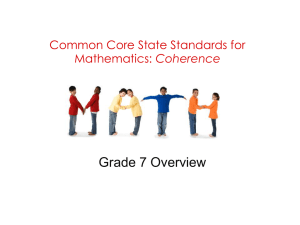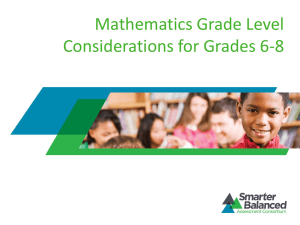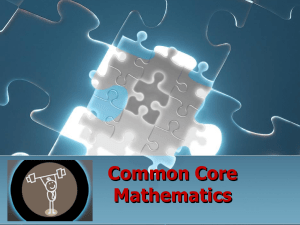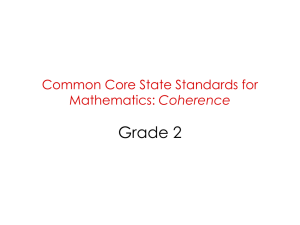Common Core State Standards for Mathematics: Coherence
advertisement
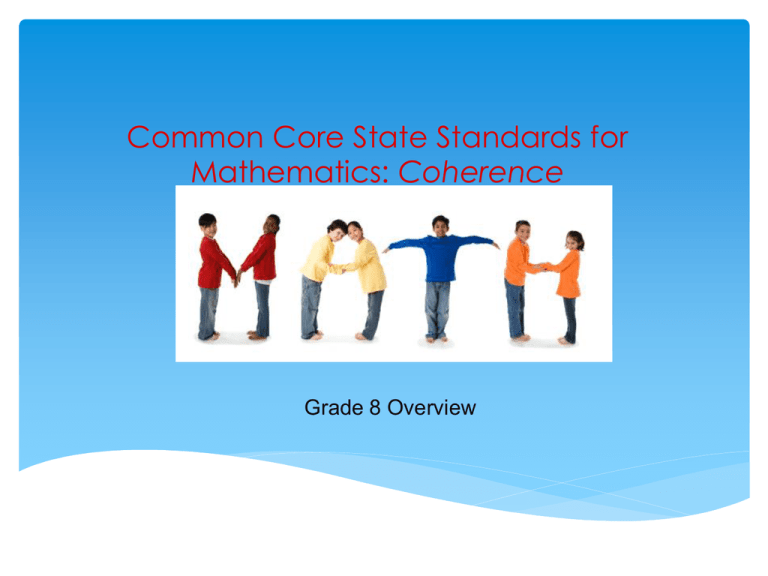
Common Core State Standards for Mathematics: Coherence Grade 8 Overview Essential Questions • • • • What are the 3 shifts in math instruction in the CCSS? Why the need for Coherence? How is coherence reflected in the classroom? What are the next steps in implementing Coherence? Shift #2: Coherence: Think Across Grades, and Link to Major Topics Within Grades • Carefully connect the learning within and across grades so that students can build new understanding on foundations built in previous years. • Begin to count on solid conceptual understanding of core content and build on it. Each standard is not a new event, but an extension of previous learning. William McCallum on Coherence Coherence: Think Across Grades Insert card activity here What does coherence look like in relation to your grade level? Engaging with the Shift: Investigate Coherence in the Standards with Respect to Expressions and Equations In the space below, copy all the standards related to Equations in the grades 6-8 Expressions and Equations Domain and note how coherence is evident in these standards. Expressions and Equations (EE) Taken from the PARCC Framework 6th grade: Solving problems by writing and solving equations (6.EE.7) involves not only an appreciation of how variables are used (6.EE.6) and what it means to solve an equation (6.EE.5) but also some ability to write, read, and evaluate expressions in which letters stand for numbers (6.EE.2). 6.EE.7 When students write equations of the form x + p = q and px = q to solve real-world and mathematical problems, they draw on meanings of operations that they are familiar with from previous grades’ work. They also begin to learn algebraic approaches to solving problems. 7th grade: In solving word problems leading to one-variable equations of the form px + q = r and p(x + q) = r, students solve the equations fluently. This will require fluency with rational number arithmetic (7.NS.1–3), as well as fluency to some extent with applying properties operations to rewrite linear expressions with rational coefficients (7.EE.1). 8th grade: Much of the work of grade 8 involves lines, linear equations, and linear functions (8.EE.5–8; 8.F.3–4; 8.SP.2–3). Students build on previous work with proportional relationships, unit rates, and graphing to connect these ideas and understand that the points (x, y) on a nonvertical line are the solutions of the equation y = mx + b, where m is the slope of the line as well as the unit rate of a proportional relationship (in the case b = 0). Students also formalize their previous work with linear relationships by working with functions — rules that assign to each input exactly one output. Examples of Key Advances from Grade 7 to Grade 8 Examples of Key Advances from Grade 7 to Grade 8 Students build on previous work with proportional relationships, unit rates, and graphing to connect these ideas and understand that the points (x, y) on a nonvertical line are the solutions of the equation y = mx + b, where m is the slope of the line as well as the unit rate of a proportional relationship (in the case b = 0). Students also formalize their previous work with linear relationships by working with functions — rules that assign to each input exactly one output. By working with equations such as x² = 2 and in geometric contexts such as the Pythagorean theorem, students enlarge their concept of number beyond the system of rationals to include irrational numbers. They represent these numbers with radical expressions and approximate these numbers with rationals. Fluency Expectations or Examples of Culminating Standards 8.EE.7 Students have been working informally with one-variable linear equations since as early as kindergarten. This important line of development culminates in grade 8 with the solution of general one-variable linear equations, including cases with infinitely many solutions or no solutions as well as cases requiring algebraic manipulation using properties of operations. Coefficients and constants in these equations may be any rational numbers. 8.G.9 When students learn to solve problems involving volumes of cones, cylinders, and spheres — together with their previous grade 7 work in angle measure, area, surface area and volume (7.G.4–6) — they will have acquired a well-developed set of geometric measurement skills. These skills, along with proportional reasoning (7.RP) and multistep numerical problem solving (7.EE.3), can be combined and used in flexible ways as part of modeling during high school — not to mention after high school for college and careers.19 Looking at Coherence within your grade level Take a look at your standards for 8th grade. Can you find some examples of coherence within your grade level? Examples of Coherence within 8th grade Examples of Major Within-Grade Dependencies An important development takes place in grade 8 when students make connections between proportional relationships, lines, and linear equations (8.EE, second cluster). Making these connections depends on prior grades’ work, including 7.RP.2 and 6.EE.9. There is also a major dependency within grade 8 itself: The angle-angle criterion for triangle similarity underlies the fact that a nonvertical line in the coordinate plane has equation y = mx + b.20 Therefore, students must do work with congruence and similarity (8.G.1–5) before they are able to justify the connections among proportional relationships, lines, and linear equations. Hence the indicated geometry work should likely begin at or near the very start of the year. Examples of Coherence within 8th grade Examples of Major Within-Grade Dependencies Much of the work of grade 8 involves lines, linear equations, and linear functions (8.EE.5–8; 8.F.3–4; 8.SP.2–3). Irrational numbers, radicals, the Pythagorean theorem, and volume (8.NS.1–2; 8.EE.2; 8.G.6–9) are nonlinear in nature. Curriculum developers might choose to address linear and nonlinear bodies of content somewhat separately. An exception, however, might be that when addressing functions, pervasively treating linear functions as separate from nonlinear functions might obscure the concept of function per se. There should also be sufficient treatment of nonlinear functions to avoid giving students the misleading impression that all functional relationships are linear (see also 7.RP.2a). Examples of Opportunities for Connections among Standards, Clusters or Domains Students’ work with proportional relationships, lines, linear equations, and linear functions can be enhanced by working with scatter plots and linear models of association in bivariate measurement data (8.SP.1–3). Sample Item from SB Sample : Consider the equation 3( 2x+5) = ax + b. Part A Find one value for a and one value for b so that there is exactly one value of x that makes the equation true. a= b= Explain your reasoning. Part B Find one value for a and one value for b so that there are infinitely many values of x that make the equation true. a= b= Explain your reasoning. Group Discussion Math Shifts 2. Coherence: Think across grades What is this shift? Why this shift? Opportunities Challenges

